Total Hip Replacement Surgery
Meaning Of Total Hip Replacement
This knowledge will help you consider the advantages and disadvantages of complete hip replacement, whether you have recently started researching medical options or have already chosen to undergo hip replacement surgery. In general, the information given here is an attempt to explain how a normal hip functions, the causes of hip pain, what to expect from hip replacement surgery, and what exercises and practices can help to regain your mobility and strength and enable you to return to daily activities. However, it is better for your operating joint repair surgeon to answer questions specific to you, since each person is special and the requirement for surgery can varies from one person to another depending on their actual health situation, lifestyle needs, and several other considerations that your operating surgeon best considers.
If arthritis, a fracture, or other diseases have affected the joint, everyday tasks such as walking or getting in and out of a chair can be uncomfortable and difficult.
You may have a sore hip, and it may be hard to put your shoes and socks on. When sleeping, you might also feel awkward.
If your symptoms are not properly eased by medicine, improvements in your daily routines, and the use of walking aids, you can recommend hip replacement surgery after talking to your joint replacement surgeon. Hip replacement surgery is a safe and reliable operation that can ease the discomfort, improve mobility, and help you return to normal daily activities.
Hip replacement surgery, first undertaken in 1960, remains one of the most effective procedures in medicine. Since 1960, the efficiency of complete hip replacement has been significantly improved by advances in joint replacement surgical procedures and technologies. More than 1.5 million cumulative hip replacements are undertaken worldwide per year, according to the Agency for Healthcare Research and Quality.
Anatomy
The hip is one of the body's largest joints. It is a ball-and-socket joint. This arrangement gives the hip a large amount of motion needed for daily activities like walking, squatting, and climbing stairs. The socket is formed by the acetabulum, which is a part of the large pelvis bone. The ball is the femoral head, which is the upper end of the femur (thighbone).
The bony surfaces of the ball and socket are covered with articular cartilage, a smooth tissue that cushions the ends of the bones and enables them to move easily.
A thin tissue called synovial membrane surrounds the hip joint. In a healthy hip, this membrane makes a small amount of fluid that lubricates the cartilage and eliminates almost all friction during hip movement.
Bands of tissue called ligaments connect the ball to the socket and provide stability to the joint.
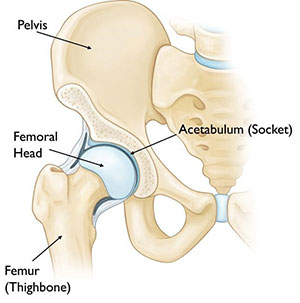
Normal hip anatomy
Common causes of hip pain
The most common cause of chronic hip pain and disability is arthritis. Osteoarthritis, rheumatoid arthritis, and post- traumatic arthritis are the most common forms of this disease which has more than 100 different types.
Osteoarthritis: This is a "wear and tear" form of arthritis associated with age. It typically happens in persons 50 years of age and older and also in people with a history of arthritis in the family. The cartilage that cushions the hip bones is wearing down. The bones then continue to brush against each other, creating discomfort and hip pain. In infancy, osteoarthritis can also be caused or accelerated by abnormalities in the growth of the hip.
Rheumatoid arthritis: This is an infectious condition in which there is inflammation and thickening of the synovial membrane. The cartilage that contributes to discomfort and stiffness may be affected by this chronic inflammation. The most prevalent example of a category of diseases called 'inflammatory arthritis' is rheumatoid arthritis.
Post-traumatic arthritis: A major hip injury or fracture may accompany this. The cartilage can become weakened and lead to hip pain and stiffness over time.
Avascular necrosis: The blood flow to the femoral head may be reduced by damage to the hip, such as dislocation or fracture. This is known as avascular necrosis, which (also commonly referred to as "osteonecrosis"). The lack of blood will cause the bone's surface to crumble and contribute to arthritis. Avascular necrosis may also be caused by certain diseases.
Childhood hip disease: Hip disorders are present in some babies and children. While during adolescence the conditions are successfully treated, later in life they can also cause arthritis. This is because there may be no natural development of the hip and the joint surfaces are disturbed.
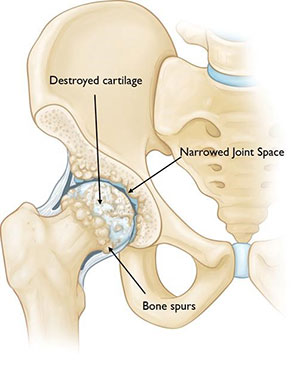
In hip osteoarthritis, the smooth articular cartilage wears away and becomes thin and rough.
Description
In a total hip replacement (also called total hip arthroplasty), the damaged bone and cartilage are removed and replaced with prosthetic components.
- The damaged femoral head is removed and replaced with a metal stem that is placed into the hollow centre of the femur. The femoral stem may be either cemented or "press fit" i.e. fixed without using cement, into the bone.
- A metal or ceramic ball is placed on the upper part of the stem. This ball replaces the damaged femoral head that was removed.
- The damaged cartilage surface of the socket is removed and replaced with a metal socket. Screws or cement are sometimes used to hold the socket in place.
- A plastic, ceramic, or metal spacer is inserted between the new ball and the socket to allow for a smooth gliding surface.

(Left) The individual components of a total hip replacement. (Centre) The components merged into an implant. (Right) The implant as it fits into the hip.
Is total hip replacement surgery for you?
The decision to have a hip replacement surgery should be a cooperative one made by you, your family,your primary care doctor or family physician, and your joint replacement surgeon. The process of making this decision typically begins with a referral by your family physician to a joint replacement surgeon (who is a qualified and trained orthopaedic surgeon on joint replacement procedures) for an initial evaluation.
Candidates for surgery
There are no absolute age or weight restrictions for total hip replacements.
Recommendations for surgery are based on a patient's pain and disability, not age. Most patients who undergo total hip replacement are between the age of 50 and 80, but orthopaedic surgeons evaluate patients individually. Total hip replacements have been performed successfully at all ages, from a young teenager with juvenile arthritis to an elderly patient with degenerative arthritis.
When is surgery recommended?
There are several reasons why your doctor may recommend a hip replacement surgery. People who benefit from a hip replacement surgery often have:
- Hip pain that limits everyday activities such as walking or bending.
- Hip pain that continues while resting, either in the day or at night.
- Stiffness in the hip that limits the ability to move or lift the leg.
- Inadequate pain relief from anti-inflammatory or painkiller medicines, physical therapy, or walking supports.
The orthopaedic evaluation
An evaluation with a joint replacement surgeon consists of several components:
Health history: The joint replacement specialist will compile your general health records and ask you about the extent of your hip pain and how it impacts your capacity to do regular activities.
Physical exam: This will test stability, strength, and alignment of the joint.
X-rays: These images help assess the hip's level of injury or deformity.
Other testing: Periodically, other tests will be used to assess the state of the bone and soft tissue of your hip, such as a magnetic resonance imaging (MRI) scan.
(Left) The gap between the ball and socket shows safe cartilage in this X-ray of a normal hip. (Right) This arthritic hip X-ray reveals significant joint space depletion
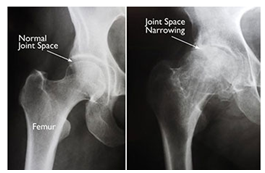
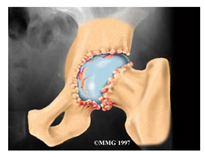
Hip Joint with arthritis
Types of Hip Replacement Surgery
Hip Replacement Surgery is classified into 3 types
- Total Hip Replacement
- Partial Hip Replacement
- Hip Resurfacing
a. Total Hip Replacement
Total hip replacement is one of the most common hip surgery. In this damaged bone and cartilage is removed and prostheses (artificial components) are used to replace the damaged hip structure. During surgical procedure, surgeons insert a stem into the patient’s femur or thighbone. Then they replace the head of the femur with a ball and replace the natural socket of hip joint with artificial cup like structure.
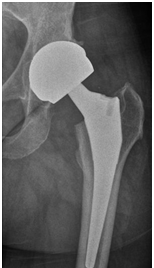
b. Partial Hip Replacement
In partial hip replacement, femoral head, which is the ball like structure at the top of a femur, or thighbone is removed and replaced. It does not replace the socket. Normally a ball unit made of metal is attached at the tip of a stem, which is inserted into the femur or thighbone. This surgery is performed to repair certain types of hip fractures. Osteoarthritis is absent in such cases, i.e. the cartilage in hip joint will be intact.
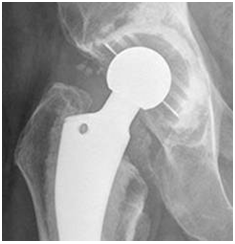
C. Hip Resurfacing
Hip resurfacing helps in relieving pain caused because of cartilage loss. Surgeon trims the damaged part of natural bone ball at the top of the femur, and then resurfaces it with a smooth metal covering. The surgeon also lines the natural bone socket of hip with a metal lining.
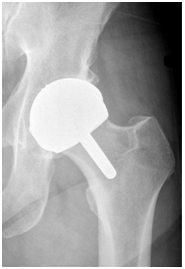
Bilateral Hip Replacement Vs Staged Hip Replacement
If both the hips need to be replaced, the surgeon may choose either bilateral way, where patient undergoes both hips replacement at same time or a staged way, where surgeon replaces one hip at a time, letting patient recover from first surgery before doing the second one.
Bilateral hip replacement is like a single visit to operating room and the potential of less recovery time requirement post surgery. But it may not work for all the patients.
Risk of blood loss during the surgery is more with bilateral hip replacement and patient is under anesthesia for longer period. Normally bilateral is more preferred for young, healthy and active patients, who can handle more rigorous physical therapy and exercise following hip replacement.
Revision Hip Replacement Surgery:
Revision hip replacement is considered for the patients who have already undergone hip replacement (total hip replacement or Partial hip replacement or hip resurfacing) and have either of the following underlying conditions
- Aseptic loosening :- Non Infectious loosening of implants
- Dislocation:- Artificial component dislocates from normal alignment
- Infection: Infection in the joint
- Implant fracture, wear & tear:- If artificial inserted components gets fractured or worn out with time
In such cases earlier components are removed and new components are inserted.
All above mentioned types are a function of many correlated things. Surgeons guide patients or caregivers through entire process and suggest them the best possible option after considering all related factor like diagnosis, complication, patient age and condition, monetary constraints, etc.
Deciding to have hip replacement surgery
Talk to your doctor
Your orthopaedic surgeon will discuss with you the outcomes of your examination and whether the right way to relieve your discomfort and enhance your mobility is to get hip replacement surgery. Other options for recovery can also be considered, such as medicine, physical therapy, or other forms of surgery.
In addition, the possible dangers and complications of hip replacement surgery, both those linked to the surgery itself and those that could arise following the surgery, can be clarified by your orthopaedic surgeon.
Do not hesitate to ask questions about things you do not hear from your doctor. The more you learn, the more you will be able to handle the changes in your life that hip replacement surgery will make.
Realistic expectancies
Understanding what the operation can and can not do is an important factor in determining whether to undergo hip replacement surgery. Many persons having hip replacement surgery report a substantial decrease in hip pain and a significant increase in hip pain.
In their capacity to perform the everyday life tasks that are normal.
The material between the head and the socket of every hip replacement implant starts to wear with regular use and exercise. This regular wear will accelerate physical exercise or becoming overweight to cause the hip replacement to loosen and become painful. Therefore, based on the general situation, most surgeons prescribe optimal high-impact behaviors such as biking, jogging, swimming, or other high-impact sports.
Unlimited cycling, swimming, golf, driving, climbing, surfing, dancing, and other low-impact sports provide practical activities after complete hip replacement. Hip repairs will last for several years with sufficient operation adjustment.
Surgery planning
Evaluation of pharmacy
Your orthopaedic surgeon may require you to have a full physical examination by your primary care doctor or doctor before your surgical operation if you plan to have hip replacement surgery.
This is needed to make sure you are healthy enough to have the surgery and complete the recovery process. Many patients with chronic medical conditions, like heart disease, may also be evaluated by a specialist, such as a cardiologist, before the surgery.
Tests
Several tests, such as blood and urine samples, an electrocardiogram (EKG), and chest X-rays, may be needed to help plan your surgery.
Preparing your skin
Your skin should not have any infections or irritations before surgery. If either is present, contact your orthopaedic surgeon for treatment to improve your skin before surgery.
Blood donations
You may be advised to donate your own blood prior to surgery. It will be stored in the event that you may need blood after surgery.
Medications
Tell your orthopaedic surgeon about the medications you are taking. He or she or your primary care doctor will advise you which medications you should stop taking and which you can continue to take before surgery.
Your doctor may encourage you to lose some weight before surgery if you are overweight, to minimize the stress on your new hip and potentially eliminate the consequences of surgery.
Dental examination- While infections following hip replacement are not common, if bacteria infiltrate the bloodstream, an infection can occur. Since bacteria can reach the bloodstream during dental operations, prior to the hip replacement surgery, major dental procedures (such as tooth extractions and periodontal work) should be performed. Since treatment, regular brushing of the teeth can be postponed for several weeks.
Urinary testing- Before surgery, people with a history of new or repeated urinary infections should have a urological assessment. Before undergoing surgery, older men with prostate cancer should seek the completion of the appropriate care.
Planning socially
- While you will be able to walk on crutches or a walker shortly after surgery, for activities such as cooking, shopping, bathing, and cleaning, you will need some support for some days or weeks. When you live alone, the office of the orthopaedic specialist, a social worker, or a hospital discharge coordinator will help you make advance plans and have someone at your home support you. During the recovery following surgery, a brief stay in an extended care hospital can also be scheduled.
- Home preparation- During your rehab, multiple changes will make your home easier to manage. With everyday activities, the following things can help:
- In your tub or bath, safety bars or handrails are tightly fastened.
- Safe handrails in both stairways.
- A stable chair with a solid seat cushion for your early recovery (that allows your knees to stay lower than your hips), a strong back, and two sides.
A sponge and shower hose with long-handles.
For putting on and taking off shoes and socks without bending your new hip unnecessarily, a dressing stick, a sock aid and a long-handled shoe horn.
A reacher that will help you to grab things without bending your hips overly.
Firm pillows that encourage you to sit with your knees lower than your shoulders for your seats, sofas, and car.
Removal from the places where you walk in your house with both loose carpet and electrical cables.
Your operation
In the day or the day before the surgery, you will most likely be admitted to the hospital.
Anaesthesia
After admission, you will be evaluated by a member of the anaesthesia team. The most common types of anaesthesia are general anaesthesia (you are put to sleep) or spinal, epidural, or regional nerve block anaesthesia (you are awake but your body is numb from the waist down). The anaesthesia team, with your operating surgeon’s input, will determine which type of anaesthesia will be best for you.
Deciding to have hip replacement surgery
Talk to your doctor
Your orthopaedic surgeon will review the results of your evaluation with you and discuss whether a hip replacement surgery is the best method to relieve your pain and improve your mobility. Other treatment options such as medications, physical therapy, or other types of surgery may also be considered.
In addition, your orthopaedic surgeon will explain the potential risks and complications of a hip replacement surgery including those related to the surgery itself and those that can occur over time after your surgery.
Never hesitate to ask your doctor questions about things you do not understand. The more you know, the better you will be able to manage the changes that hip replacement surgery will make in your life.
Realistic expectations
An important factor in deciding whether to have hip replacement surgery is understanding what the procedure can and cannot do. Most people who undergo hip replacement surgery experience a dramatic reduction of hip pain and a significant improvement in their ability to perform the common activities of daily living.
With normal use and activity, the material between the head and the socket of every hip replacement implant begins to wear. Excessive activity or being overweight may speed up this normal wear and cause the hip replacement to loosen and become painful. Therefore, most surgeons advise optimum high-impact activities such as running, jogging, jumping, or other high-impact sport depending upon your general conditions.
Realistic activities following total hip replacement include unlimited walking, swimming, golf, driving, hiking, biking, dancing, and other low-impact sports.
With appropriate activity modification, hip replacements can last for many years.
Implant components
Many different types of designs and materials are currently used in artificial hip joints. All of them consist of two basic components: the ball component (made of highly polished strong metal or ceramic material) with a femoral stem for the thighbone and the socket component (a durable cup of plastic, ceramic or metal, which may have an outer metal shell).
The prosthetic components may be "press fit" into the bone to allow your bone to grow onto the components or they may be cemented into place. The decision to press fit or to cement the components is based on a number of factors, such as the quality and strength of your bone. A combination of a cemented stem and a non-cemented socket or vice versa may also be used depending upon the overall planned outcome and your clinical needs.
Your orthopaedic surgeon will choose the type of prosthesis that best meets your needs.

(Left) A standard non-cemented femoral component. (Centre) A close-up of this component showing the surface for bone growth. (Right) The standard cemented femoral component.
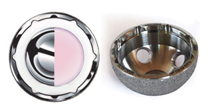
(Left) The acetabular component shows plastic (polyethene) liner inside the metal shell and metal or ceramic head. (Right) The porous surface of this acetabular component allows for bone ingrowth. The holes around the cup are used if screws are needed to hold the cup in place.
Implant components are made up of different types of materials like Titanium, Cobalt Chrome, Stainless Steel, Tantalum, Ceramic and Polyethylene. Out of which Titanium and Cobalt chrome are best suited for the stem and cup manufacturing respectively. Whereas Ceramic, Stainless Steel and Cobalt Chrome forms the femoral head – ball like structure.
The choice of bearing options is based on different factors like procedure type (total hip replacement or Partial hip replacement), age of the patient, bone quality and cost constraints if any.
Types of Implants
We design hip implants to mimic the natural movement of the body. The primary difference between implants is their size and the material used for the components.
Hip implant components are made up of polyethylene (plastic), metal, ceramic or a combination of different materials.
Metal-on-Polyethylene (MoP)
One of the most common types of hip implant, metal-on-polyethylene has been used since early 1960s. The ball is made up of metal and the socket has a plastic lining or is entirely made of polyethylene. Plastic has a smooth surface that causes little friction while the ball moves within the socket. However, MoP implants can produce plastic debris, which can eventually lead to implant failure. Wear debris from the breakdown of materials\ could lead to a condition called osteolysis, which occurs when inflammation destroys the bone and the implant positioned in the bone loosens.
Metal-on-Metal (MoM)
Metal-on-metal hip devices are no longer available freely, though thousands of people may have been implanted with them. Around the turn of the century, many new hip implants were made from metal-on-metal components, meaning the ball, stem and socket were all made out of metal. Manufacturers believed the metals were more durable than other materials. However, MoM hip implants can shed metal particles that may cause a number of serious health issues, including a type of metal poisoning called metallosis. Several models of metal-on-metal hips were recalled or taken off the market because of health concerns.
Ceramic-on-Polyethylene (CoP)
Ceramic-on-polyethylene devices couple a ceramic ball with a socket made from plastic. They may also substitute the plastic socket for a polyethylene lining in the natural socket. With plastic parts, there is still a risk of wear that causes debris and leads to osteolysis.
Ceramic-on-Ceramic (CoC)
Ceramic-on-ceramic devices combine a ceramic head with a ceramic lining in the hip socket. It is considered to be the most successful option which imparts lesser friction due to smooth surfaces and prolongs durability of the implant. Price wise this is a premium priced bearing option.

Hip replacement Surgical Procedure
The surgical procedure takes a few hours. Your orthopaedic surgeon will remove the damaged cartilage and bone and then position new metal, plastic, or ceramic implants to restore the alignment and function of your hip.

X-rays before and after total hip replacement. In this case, non-cemented components were used.
After surgery, you will be moved to the recovery room where you will remain for several hours while your recovery from anaesthesia is monitored. After you wake up, you will be taken to your hospital room.
